局解试题英文
- 格式:docx
- 大小:190.37 KB
- 文档页数:14
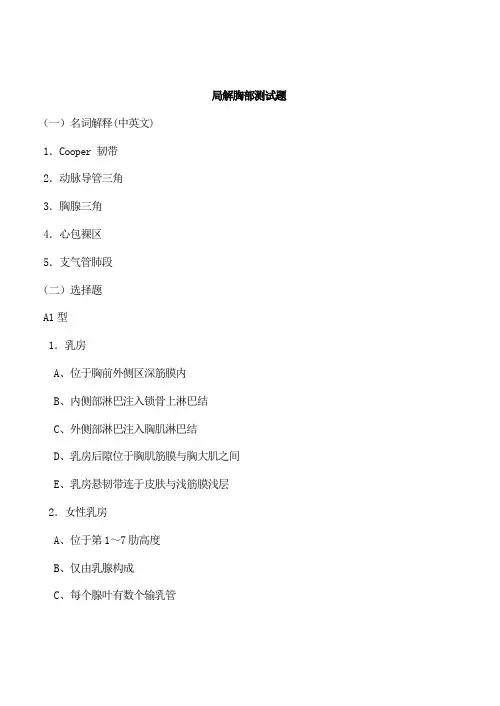
局解胸部测试题(一)名词解释(中英文)1.Cooper 韧带2.动脉导管三角3.胸腺三角4.心包裸区5.支气管肺段(二)选择题A1型1.乳房A、位于胸前外侧区深筋膜内B、内侧部淋巴注入锁骨上淋巴结C、外侧部淋巴注入胸肌淋巴结D、乳房后隙位于胸肌筋膜与胸大肌之间E、乳房悬韧带连于皮肤与浅筋膜浅层2.女性乳房A、位于第1~7肋高度B、仅由乳腺构成C、每个腺叶有数个输乳管D、与胸肌筋膜之间有乳房后隙E、乳腺脓肿亦作低位横行切口引流 3.上纵隔最前方的结构是A、左、右头臂静脉B、上腔静脉C、气管D、主动脉弓E、胸腺4.肋间神经A、即第1~12对胸神经前支B、始终行于肋间隙中间C、与肋间后动、静脉伴行D、在腋前线处浅出移行为前皮支E、以上都不对5.胸骨角A、为胸骨柄和剑突交界处B、两侧平对第2肋软骨C、是计数椎骨的唯一标志D、向后平对第5胸椎下缘E、后面与心包相邻6.胸膜腔A、由脏、壁胸膜共同围成的密闭窄隙B、由壁胸膜相互返折而成C、可通过呼吸与外界相通D、左、右胸膜腔经气管相通连E、其内有左、右肺和少量液体7.肺根A、位于胸膜腔内B、是出入肺门结构的一部分C、其前方邻迷走神经D、后方邻膈神经E、右肺根上方与奇静脉相邻8.肺下界在肩胛线平对A、第10肋B、第8肋C、第11肋D、第12肋E、第10胸椎棘突9.纵隔A、位于左、右肺之间B、是心包和心的总称C、右侧面观可见食管上、下三角D、左侧面观只能看到心包E、以上都不对10.上纵隔A、由上至下分为3层B、前层有膈神经C、中层有上腔静脉D、后层有主动脉弓E、后层有胸导管11.动脉导管三角A、位于主动脉弓右后方B、前界为左迷走神经C、后界为左膈神经D、上界为左肺动脉E、其内有动脉韧带等12.心包腔A、位于纤维性心包与浆膜性心包之间B、在某些部位形成隐窝,即心包窦C、心包横窦位于上、下腔静脉之间D、心包腔积液首先积于心包横窦E、以上都不对13.食管胸段A、以主动脉弓下缘为界分为胸上、下2段B、既属上纵隔器官也是后纵隔器官C、有3个生理性狭窄D、第3个狭窄位于与左主支气管相交处E、以上都不对14.食管胸段的毗邻A、前有气管、气管杈、心包和左心房B、后有胸导管和主动脉弓及其分支C、左为奇静脉、半奇静脉和副半奇静脉D、右有胸主动脉、迷走神经和胸交感干E、以上都不是15.食管胸段A、主要由胸主动脉食管支和肋间后动脉分支供血B、静脉完全与动脉同名称、同行程C、食管静脉注入上腔静脉和下腔静脉D、食管静脉向下与胃右静脉相吻合E、以上都不是16.不属后纵隔的结构是A、食管B、胸主动脉C、气管D、胸导管E、奇静脉17.气管胸部A、是自喉至气管杈之间的一段气管B、在胸骨角平面分为左、右主支气管C、气管隆嵴是气管胸部起点的标志D、在成人其前方邻胸腺E、后方有头臂静脉和上腔静脉18.胸导管A、起自胸部乳摩池B、经食管裂孔入胸腔C、位于中纵隔内D、行于胸主动脉与奇静脉之间E、在第3胸椎平面斜行向左19.胸导管下段的毗邻A、前方为右肋间后动脉B、后方为食管C、左侧有奇静脉D、右侧有胸主动脉E、以上都不是20.奇静脉A、由左、右腰升静脉合成B、经腔静脉孔入胸腔C、绕右肺根上方注入上腔静脉D、收集左侧肋间后静脉的血液E、以上都不是21.胸交感干A、位于脊柱胸段两侧、肋头前方B、每侧交感干有三个神经节C、第1胸节与颈中神经节合并成星状节D、自第10~11交感节发出内脏大神经E、自第12交感节发出内脏小神经22.膈A、分为胸前部.肋部和腰部B、胸肋三角位于椎骨与肋之间C、腰肋三角位于膈腰部和肋部之间D、主动脉裂孔有降主动脉和迷走神经通过E、食管裂孔有食管和奇静脉通过23.胸壁A、以肋和胸骨为支架组成B、参加围成胸腔C、被纵隔分为左、右二部D、分为胸前区和胸背区E、主要由胸廓内动脉供血24.肋间神经A、共有12对B、行于浅、深筋膜之间C、只支配胸壁的肌肉和皮肤D、分布于胸、腹壁的肌肉和皮肤E、于腋前线浅出易名为外侧皮支25.胸膜腔穿刺术的最佳部位A、肋角内侧、下位肋的上缘B、肋角外侧、上位肋的下缘C、肋角外侧,6-7肋之间D、肋角内侧.6-7肋之间E、肩胛线8-9肋之间26.胸腔A、为一底向下凸的锥形腔B、由胸壁和膈围成C、是脏、壁胸膜之间的腔隙D、向下通腹腔E、内有少量浆液27.肺根A、主要结构为主支气管,肺动、静脉B、位于两肺门之间C、是固定肺的唯一结构D、向下延伸形成肺韧带E、以上都不是28.胸膜前界A、为肋胸膜与膈肋膜前缘的返折线B、于第2~6胸肋关节平面相互靠拢C、向上分开形成心包三角D、向下分开形成胸腺三角E、向上、下分开形成两个三角形无胸膜区 29.食管上三角A、由脊柱和左锁骨下动脉围成B、在纵隔右侧面C、内有食管和胸导管D、无胸膜覆盖E、以上都不是30.食管的第2个狭窄A、位于食管与右主支气管相交处B、是主动脉弓和左主支气管挤压所致C、有增厚的功能性括约肌D、有很重要的生理意义E、是病变最少的部位31.胸主动脉A、在第3胸椎下缘续于主动脉弓B、沿脊柱右侧下行C、前方邻奇静脉D、后方邻食管E、主要壁支为肋间后动脉32.不属于上纵隔的器官是A、胸腺B、食管C、气管D、上腔静脉E、奇静脉33.心尖的体表投影在A、左第5肋向隙锁骨中线内侧1~2cm处B、左第5肋向隙锁骨中线外侧1~2cm处C、左第4肋向隙锁骨中线内侧1~2cm处D、左第4肋向隙锁骨中线外侧1~2cm处E、左第4肋向隙胸骨旁线外侧1~2cm处 A2型34.一患乳腺脓肿的病人,医生决定作放射状切口引流,其原因是A、以免损伤输乳管B、以免损伤血管,神经C、以免损伤乳腺D、以免损伤Cooper韧带E、便于脓液引流35.医生在为某女患者检查时,发现该患者右侧乳房有一肿块,肿块处的皮肤呈"桔皮样'变,医生首先应考虑病人患有A、急性乳腺炎B、乳房后隙脓肿C、乳腺小叶脓肿D、乳腺癌E、输乳管不通36.肋间神经封闭时,首选部位是肋角至腋后线之间,是因为A、该处神经恒定地走行在肋沟B、此处神经不与血管伴行C、神经行于血管上方,不易受损D、此处无肋间肌易于进针E、此处神经位置很表浅37.某心跳突然停止的病人,医生决定在胸骨左缘,第4肋间隙作心内注射以抢救病人,是因为此处A、无血管B、无神经C、无胸膜D、无心包E、无肋间肌38.某病人食管癌手术后出现左侧乳糜胸,是损伤了A、食管B、气管C、胸导管下段D、胸导管上段E、纵隔淋巴结B1型题问题 39-41A、胸骨角B、胸骨下角C、剑肋角D、肋角E、胸腺三角(39)平对第2肋软骨的是(40)内有剑突的是(41)胸膜返折形成的是问题 42-44A、胸腺B、气管C、胸导管D、迷走神经E、喉返神经(42)成人已退化的器官(43)在第四胸椎平面分杈的是(44)在第四胸椎平面改变行程的是(三)填空题1.胸前,外侧区的皮神经来自_________和________的分支 2.乳房主要由_____,______和_____构成.3.胸膜分为______和______二部4.心包腔由浆膜性心包______和_____围成5.肺段是指一个肺_______及其所属的_______6.纵隔四分法,首先将其分为______和______,又被分为_______,______和_______7.头臂静脉由______和______在胸锁关节后方合成.8.上腔静脉由_______和_____合成,注入______9.动脉导管三角内有_______,_________和心浅丛10.右主支气管较左主支气管________,其走向_____11.两侧胸膜前界返折时形成两个三角形无胸膜区,即_______和_______。
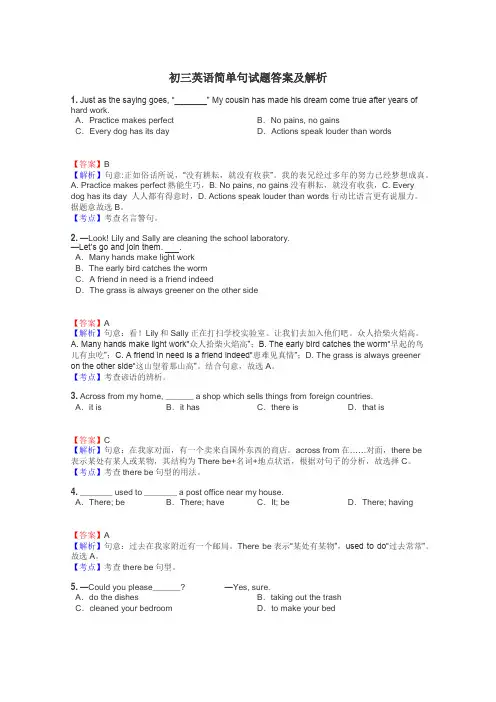
初三英语简单句试题答案及解析1.Just as the saying goes, “_______” My cousin has made his dream come true after years of hard work.A.Practice makes perfect B.No pains, no gainsC.Every dog has its day D.Actions speak louder than words【答案】B【解析】句意:正如俗话所说,“没有耕耘,就没有收获”。
我的表兄经过多年的努力已经梦想成真。
A. Practice makes perfect熟能生巧,B. No pains, no gains没有耕耘,就没有收获,C. Every dog has its day 人人都有得意时,D. Actions speak louder than words行动比语言更有说服力。
据题意故选B。
【考点】考查名言警句。
2.—Look! Lily and Sally are cleaning the school laboratory.—Let’s go and join them. .A.Many hands make light workB.The early bird catches the wormC.A friend in need is a friend indeedD.The grass is always greener on the other side【答案】A【解析】句意:看!Lily和Sally正在打扫学校实验室。
让我们去加入他们吧。
众人拾柴火焰高。
A. Many hands make light work“众人拾柴火焰高”;B. The early bird catches the worm“早起的鸟儿有虫吃”;C. A friend in need is a friend indeed“患难见真情”;D. The grass is always greener on the other side“这山望着那山高”。
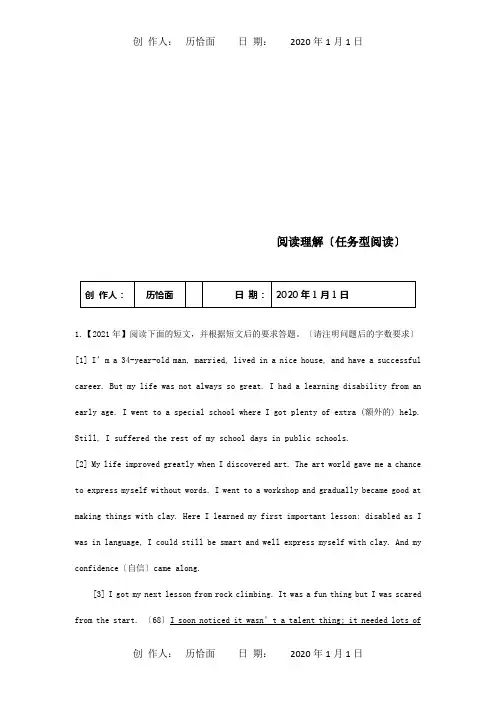
阅读理解〔任务型阅读〕创作人:历恰面日期:2020年1月1日1.【2021年】阅读下面的短文,并根据短文后的要求答题。
〔请注明问题后的字数要求〕[1] I’m a 34-year-old man, married, lived in a nice house, and have a successful career. But my life was not always so great. I had a learning disability from an early age. I went to a special school where I got plenty of extra (额外的) help. Still, I suffered the rest of my school days in public schools.[2] My life improved greatly when I discovered art. The art world gave me a chance to express myself without words. I went to a workshop and gradually became good at making things with clay. Here I learned my first important lesson: disabled as I was in language, I could still be smart and well express myself with clay. And my confidence〔自信〕came along.[3] I got my next lesson from rock climbing. It was a fun thing but I was scared from the start. 〔68〕I soon noticed it wasn’t a talent thing; it needed lots ofpractice. So I did it more. After about five years of climbing, I found myself in Yosemite Valley on a big wall. I learned that if you fall in love with something and do it all the time, you will get better at it.[4] Later I decided to learn (69) ① to read and write. I practiced reading and(69)② , which I used to avoid as much as possible. After two years,I was literate(有文化的).[5] Through the long process with art, (69) ③ , and reading and writing, now I’ve got to a point in my life: I am smart enough to dive into (潜入) an area that is totally unknown, hard, but interesting.46. What made the writer’s school days difficult? (No more than 5 words)_________________________________________________________47. Why did art give the author confidence? (No more than 11 words)_________________________________________________________48. Translate the underlined sentence in the third paragraph into Chinese._________________________________________________________49. Fill in the blanks in the last two paragraphs with proper words.①__________________ ②________________ ③_______________50. What have you learned from the passage? (No more than 20 words)_________________________________________________________【答案】46. His/A learning disability. Or: Having a learning disability. Or: He hada learning disability.47. Because he could be smart and well express himself with clay.Or: Because art could help him express himself without words.Or. Because he could well express himself with clay/art.Or: Because art gave him a chance to express himself without words.48. 我很快注意到,它不是—件靠天赋 (完成〕的事情:而是需要大量的练习。
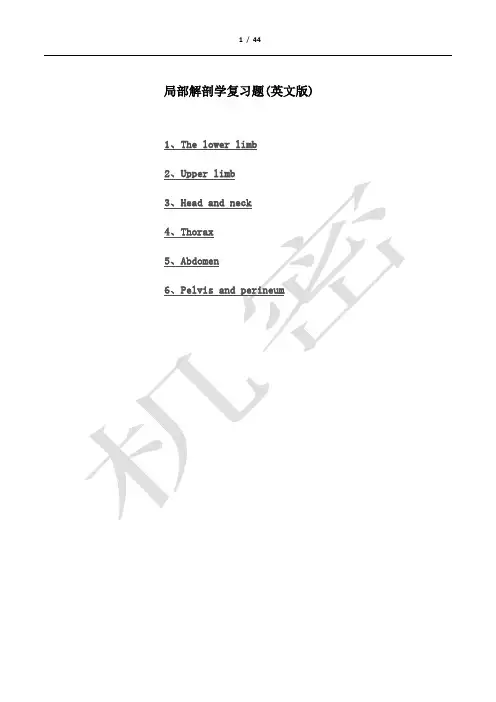
局部解剖学复习题(英文版) 1、The lower limbThe lower limbSingle-choice questions1. Which structure does not pass through the lessor sciatic foramenA. pudendal nerveB. internal pudendal arteryC. internal pudendal veinD. obturator internusE. priformis2.The femoral sheathA. is a funnel shaped fascial tubeB. is a prolongation of deep fascia of the thighC. opens downwards into Hunter’s canalD. can be divided into three compartmentsE. encloses the femoral artery,vein and nerve3.The deepest structure in the popliteal fossa isA. popliteal arteryB. popliteal veinC. popliteal lymph nodeD. tibial nerveE. common peroneal nerve4.Which structure is easily damaged when fracture occurred at the neck of fibulaA. popliteal arteryB. common peroneal nerveC. tibial nerveD. anterior tibial arteryE. fibular artery5.Which muscle can flex the hip and knee joint?A. quadriceps femorisB. sartoriusC. adductor longusD. pectineusE. adductor magnus6.Which muscle can flex the hip joint and extend the knee joint? A. sartoriusB. adductor longusC. biceps femorisD. quadriceps femorisE. gracilis7.Which muscle can evert the foot?A. peroneus longusB. the tibialis anteriorC. the tibialis posteriorD. the soleusE. flexor digitorom brevis8.Which muscle can invert the foot?A. Aperoneus longusB. popliteusC. tibialis posteriorD. flexor hallucis longusE. flexor digitorum longus9.Concerning triceps surae, the right description is:A. the gastrocnemius lies deeply to the soleus.B. the tendo calcaneus inserts on the calcaneus bone.C. it can extend the ankle joint.D. the gastrocnemius arises from the posterior surfaces of the tibia and fibulaE. the soleus arises from the medial and lateral condyles of the femur.10.The following structures pass through the greater sciatic foramen, except the :A. superior gluteal artery.B. sciatic nerve.C. obturator internus tendon.D. pudendal nerve.E. inferior gluteal nerve.11.The following structure which may be damaged by supracondylar femoral fractureA. politeal a.B. femoral a.C. common peroneal n.D. anterior tibial a.E. posterior tibial a.12.Which artery is palpable deep to the ingunal ligamentA. anterior tibial a.B. femoral a.C. politeal a.D. profunda femoris arteryE. peroneal a.13.Deep peroneal n. suppliesA. Tibialis anteriorB. tibialiis posteriorC. Peroneus longusD. Peroneus brevisE. gastrocnemius14.The following nerves which damaged may result in foot drop?A. femoral n.B. tibial n.C. common peroneal n.D. obturator n.E. pudendal n.15.The following structures pass through the infrapiriform foramen foramen, excepttheA. superior gluteal artery.B. sciatic nerve.C. posterior femoral cutaneous n.D. pudendal nerve.E. internal pudendal vein and artery.16.The only innervation of the femoral nerve below the level of the knee is:A. the gracilis muscleB. the tibialis anterior muscleC. the skin of the lateral side of footD. the adductor longusE. the skin on the medial side of leg17.Regarding the femoral triangleA. the femoral vein, artery, and nerve lie in the femoral sheath.B. the femoral nerve lies most medially in the femoral triangle.C. the lateral border of the femoral triangle is formed by the lateral border of sartorius muscleD. the femoral canal lies medial to the femoral vein.E. at the apex of the femoral triangle the femoral vessels pass into the popliteal fossa.18.The anterior tibial artery:A. is a branch of the femoral a.B. begin at level of the lower border of the popliteusC. passes through the adduct canal.D. supplies the dorsiflexor muscles.E. is palpable in the foot.19.The contents of the popliteal fossa, except theA. tibial nerveB. common peroneal nerveC. popliteal vein and its tributariesD. popliteal artery and its branchesE. deep peroneal nerve20.Concerning nerves of the lower limb:A. the obturator nerve supplies the muscles of the anterior compartment of the thigh.B. the sciatic n. leaves the pelvis via the greater sciatic foramen.C. the femoral nerve originates from the pelvic plexus.D. the superior gluteal n.supplies the gluteus maximus m.E. the sciatic n. may be damabed by posterior dislocation of the hip joint.Answer1.E2.A3. A4. B5. B6. D7. A8. C9. B 10. C 11. A 12. B 13. A 14. C 15. A 16. E 17. D 18. B 19. E 20. BMultiple-choice questions of lower limb21.The great saphenous veinA. begins on the medial side of the dorsaum of the footB. runs upwards posterior to the medial malleolusC. accompany with the saphenous nerve on the medial surface of the legD. ascends on the posteromedial surface of the kneeE. enter the femoral vein through the saphenous hiatus22.The structures passing through the lacuna musculorum areA. femoral nerve.B. femoral artery and femoral veinC. iliopsoasD. lateral femoral cutaneous nerveE. femoral sheath23.The structures passing through the lacuna vasorum areA. femoral sheathB. femoral nerveC. lymphatic vesselsD. pectineusE. femoral artery and vein24.Femoral canalA. is located in the femoral triangleB. contains the femoral artery and veinC. contains the small intestineD. is closed by femoral septum at the upper opening(femora ring)E. opens downwards into the saphenous hiatus25.The adductor canalA. is a deep ferrow on the medial side of the middle of the thighB. continues upperwards with femoral triangleC. ends in the adductor tendinous openingD. transmits the femoral artery and veinE. transmits the saphenous nerve26.The suprapiriform foramen transmitsA. piriformisB. superior gluteal arteryC. superior gluteal nerveD. obturator internusE. sacrospinous ligament27.The infrapiriforam foramen transmitsA. sciatic nerveB. inferior gluteal artey and veinC. pedendal nerveD. internal pudendal artery and veinE. inferior gluteal nerve28.The structures pass through both the greater and lessor sciatic foramen areA. piriformisB. sciatic nerveC. pedendal nerveD. internal pudendal artery and veinE. obturator internus29.The fascia lataA. is the deep fascia of the thigh and buttockB. is thicked on the lateral side and is known as the iliotibial tractC. encloses the tensor fascia latae superiorlyD. is perforated by great saphenous vein inferolateral to the pubic tubercle and known asthe saphenoushiatusE. can provide an insertion for the gluteus maximus posteriorly30.Which muscles do belong to the posterior group of the muscles of hip?A. gluteus maximusB. gluteus mediusC. piriformisD. obturator internusE. quadratus femoris31.Gluteus maximus originates fromA. gluteal surface of iliumB. dorsal aspect of sacrumC. coccyxD. sacrotuberous lig.E. sacrospinous lig.32.The posterior facial compartment of the thigh consists ofA. biceps femorisB. semitendinosusC. semimembranosusD. sciatic nerveE. tensor fasciae latae33.The tibial nerve supplies:A. tibialis anterior.B. tibialis posteriorC. gastrocnemius.D. soleus.E. skin of sole of the foot.34.Structures that pass through the malleolus canal areA. tibialis posterior tendonB. flexor digitorum longusC. common peroneal n.D. tibial n.E. flexor hallucis longus35.Concerning nerves of the lower limb:A. the obturator nerve supplies the muscles of the adductor compartment of the thigh.B. the sciatic n. leaves the pelvis via the greater sciatic foramen.C. the femoral nerve originates from the pelvic plexus.D. the superior gluteal n. supplies the gluteus maximus m.E. the sciatic n. may be damaged by posterior dislocation of the hip joint.36.In the thighA. satorius is attached to the anterior inferior iliac spine.B. the superior of the femoral ring is covered by femoral septumC. the great saphenous v. passes through the saphenous opening in the deep fascia and joinsthe femoral veinD. at the inguinal ligament the femoral v. is lateral to the femoral a.E. laterally the deep fascia forms a thick band, the iliotibial tract.37.At ankle and in the foot:A. the great saphenous vein is posterior to the medial malleolus.B. tibialis posterior tendon passes deep to the flexor retinaculum.C. eversion and inversion mainly take place at the ankle joint.D. the tendo calcaneus is attached to the talus.E. Dorsalis pedis artery begins in front of the ankle joint as a continuation of the anteriortibial a..38.Regarding vessels of the lower limb:A. the femoral a. is a direct continuation of the internal iliac a.B. the profunda femoris a. supplies the muscles of the medial and posterior compartmentsof the thigh.C. the popliteal a. has no branches in the popliteal fossa.D. the dorsalis pedis a. is a continuation of the anterior tibial a. in the footE. the posterior tibial a. may be palpated behind the lateral malleoulus39.The posterior tibial artery:A. is abranch of the femoral artery.B. is related to the medial malleolus.C. Divides into medial and lateal plantar ateries.D. supplies dorsoflexor.E. is accompanied by the sural nerve.40.The structures passing through the malleolar canalA. Tibialis posteriorB. extensor hallucis longusC. Posterior tibial arteryD. tibial nerveE. Flexor digitirum longusAnswer21. ACDE 22. ACD 23. ACE 24. ACD 25. ABCDE 26. BC 27. ABCDE 28. CD 29. ABCDE 30. ABCDE 31. ABD 32. ABCD 33. BCDE 34. ABDE 35. ABE 36. BCDE 37. BE 38. BDE 39. BC 40. ACDEAnswer questions of lower limb1.Describe the origin, insertion, action and nerve supply of ①gluteus maxim, ②piriformis, ③gastrocnemius and soleus, ④tibialis posterior, ⑤sartorius, ⑥quadriceps femoris, ⑦tibialis anterior.2.Describe the structures passing through the suprapiriform foramen, infrapiriform foramenand lesser sciatic foramen.3.Describe the origin, course and distribution of the sciatic nerve.4.Describe the origin, branches and distribution of the femoral nerve.5.Describe the origin and distribution of the① tibial nerves, ②superficial peronealnerve and ③deep peroneal nerves..6.Describe the beginnings, course and endings of greater and lesser saphenous veins. Describe the boundaries and contents of the ①femoral triangle, ②adductor canal, ③popliteal fossa, ④malleolar canal, ⑤femoral ring, ⑥lacuna musculorum, ⑦lacuna vasorum.8.Describe the main arterial tree of the lower limb. Name three sites where peripheral pulsemay be palpated. Where are these vessels liable to injury?9.Briefly describe the innervation of the muscles which evert and invert the footUpper limbSingle choice questions of upper limb1.The lymph nodes along the lateral thoracic vessels areA. the pectoral lymph nodesB. the lateral lymph nodesC. the subscapular lymph nodesD. the central lymph nodesE. the apical lymph nodes2.Concerning the muscles of the upper limb, which is false?A.The supinator muscles forms the floor of the cubital fossa.B.The median nerve passes between the two heads of pronator teres as it leaves the cubitalfossa.C.The median nerve passes to the hand through the carpal canalD.The ulnar nerve enters the forearm superficial to the two heads of flexor carpi ulnaris.E.The deltoid muscle is supplied by the axillary nerve3.Which muscle is innervated by both the ulnar and median nerves?A.flexor digitorum superficialisB.pronator quadratusC.flexor digitorum profundusD.supinatorE.none of the above4. A fall on the elbow fractures the medial epicondyle and damages important adjacentstructures. Among the deficits listed below, select the one most likely to be encountered in this patient:A.inability to flex the wristB.inability to extend the wristC.inability to oppose the thumbD.inability to grasp a piece of paper tightly between the extended 2nd and 3rd finger.E.inability to abduct the wrist5.Concerning the basilic vein, which is true?A.begins at the ulnar side of the dorsal venous network of handB.begins at the radial part of the dorsal venous network of handC.ascends along the lateral part of the armD.pass through the groove between the pectoralis major and deltoidE.end in the subclavian vein6.The cephalic veinA.arises from the medial side of dorsal venous rete of handB.accompany the radial arteryC.drain into the brachial v.D.receives the superficial veins of the hand and the medial side of the forearmE.runs along the lateral side of the biceps brachi.7.Which nerve injured can lead to “claw hand”(爪形手)?A.musculocutaneous nerveB.median nerveC.ulnar nerveD.axillary nerveE.radial nerve8.Which nerve injured can lead to “Ape-like”hand (猿掌)?A.musculocutaneous nerve and median nerveB.median nerve and ulnar nerveC.ulnar nerve and axillary nerveD.axillary nerve and radial nerveE.radial nerve9.Which nerve injured can lead to “wristdrop”(垂腕)?A.musculocutaneous nerveB.median nerveC.ulnar nerveD.axillary nerveE.radial nerve10.Which nerve passes through the quadrilateral foramen?A.musculocutanous nerveB.median nerveC.ulnar nerveD.radial nerveE.axillary nerve11.The axillary arteryA.begins from the medial border of the ist ribB.gives off the internal thoracic arteryC.ends at the lower border of the teres minorD.its branches distribute to the pectoralis major m. onlyE.gives off the anterior intercostal artery12.Which nerve arises from the lateral cord of brachial plexusA.musculocutaneous nerveB.ulnar nerveC.medial pectoral nerveD.radial nerveE.thoracodorsal nerve13.The apex of axilla is bounded byA. lateral 1/3 of clavicleB. medial border of scapulaC. lateral border of first ribD. head of humerusE. pectoralis major14.Which structure accompany with radial nerve passing through humeromuscular tunnelA.nutrient vessels of humerusB.deep brachial arteryC.radial arteryD.ulnar arteryE.brachial artery15.Regarding the median nerve, which is trueA.arises from brachial plexus with the lateral and medial rootB.lies to the medial side of axillaty arteryC.lies to the lateral side of brachial artery all throughD.accompanies the deep brachial vessles along the armE.lies to the lateral side of brachial artery in the cubital fossa16.Deep palmar archA.is formed by the anastomosis of the terminal part of the radial artery with deep branchof the ulnar ateryB.is formed by the anastomosis of the terminal part of the ulnar artery with deep branchof the radial arteryC.lies superficial to the tendons of flexor musclesD.lies superficial to the lumbricalesE.gives off three common palmar digital ateries17.Concerning musculocutaneous nerve, which is true?A.arises from medial cord of brachial plexusB.innervates triceps brachiiC.innervates posterior group of muscles of armD.perforates the coracobrachialis and control itE.accompanies deep brachial vessels18.Regarding the radial nerve, which is true?A.It arises from the medial cord of the brachial plexus.B.It lies to the medial side of the brachial artery.C.It has no branches in the arm .D.It is easily injured when the fracture of the surgical neck of humerus.E.It runs posteriorly with the deep brachial artery19.Concerning biceps brachii, which is true?A.It lies deep to the lower half of the coracbrachialis.B.It is the chief extensor of the forearm.C.Its long head can also extend the shoulder jointD.The short head arise from the coracoid processE.It flexes the wrist joint20.Which one does not pass through the carpal canal?A. the common flexor sheathB. the tendons of the flexor digitorum superficialisC. The tendon of flexor pollicis longusD. the median nerveE. the ulnar nerveAnswer1.A2. D3. C4. D5. A6. E7. C8. B9. E 10. E 11. C 12. A 13. C 14. B15. A 16. A 17.D 18.E 19. D 20. EMultiple-choice questions of upper limb21.The cephalic veinA. arises from the lateral side of dorsal venous rete of handB. runs along the lateral side of the biceps brachiC. accompany the radial arteryD. receives the superficial veins of the hand and the medial side of the forearmE. drain into the axillary vein22.Regarding the deltoid, the right description includeA.It is the most powerful abductor of the armB.Its anterior part is a strong flexor and lateral rotation of humerusC.It is inserted into the deltoid tuberosity of humerusD.It forms the rounded contour (轮廓) of the shoulderE.It protects and acts the shoulder joint23.Concerning the triceps brachii, the right description includeA.Its long head arise from the infraglenoid tuberosity of scapulaB.Its lateral head arise from the posterior surface of the humerus below the groove forradial nerveC.Its medial head arise from the posterior surface of the humerus above the groove forradial nerveD.The strong tendon of it is inserted into the olecranon of ulnaE.Its medial head can extend and adduct the shoulder joint24.Regarding the pronator teres, the right description includeA.It arises from the medial epicondyle of humerus and the deep fascia of forearmB.It only pronates forearmC.It only flexes elbow jointD.It belongs to the superficial layer of the anterior group of the muscles of forearmE.It flexes the thumb25.Which muscles have the function of opposition(对掌)A.Abductor pollicis brevisB.Flexor pollicis brevisC.Opponens pollicisD.Opponens digiti minimiE.Lumbricales26.Regarding the brachial artery, the right descriptions includeA.It is the continuation of the subclavian arteryB.Begins at the inferior border of the teres majorC.Runs downwards on the medial side of the biceps brachiiD.Its pulsation can be feltE.The deep brachial artery is its branch27.Concerning the radial artery, the right descriptions includeA.In the wrist, it is used clinically for taking the pulseB.It arises from the brachial a. in the elbowC.Give off the superficial palmar branch to handD.The principal artery of thumb is its branchE.It takes part in the formation of deep palmar arch28.Regarding the superficial palmar arch, the right descriptions includeA.It is formed by the anastomsis of the terminal part of the ulnar artery with thesuperficial palmar branch of the radial arteryB.It is covered by the palmar aponeurosisC.It lies on the flexor tendons of the fingersD.It gives off three common palmar digital arteriesE.It gives off the principal artery of thumb29.Concerning the deep palmar arch, the right descriptions includeA.It is formed by the anastomsis of the terminal part of the radial artery with the deeppalmar branch of the ulnar artery.B.It gives off three palmar metacarpal arteriesC.It gives off three common palmar digital arteriesD.It lies the proximal to the level of the superficial palmar archE.The branches of the arch supply the bones and muscles of the hand30.The superficial veins of the upper limb includeA.The cephalic veinB.The axillary veinC.The median cubital veinD.The basilic veinE.The radial vein31.Regarding the cephalic vein, the right descriptions includeA.It ends in the brachial veinB.It ascends along the radial side of the armC.It ascends the medial of the biceps brachiiD.It begins the radial part of the dorsal venous rete of handE.It ends in the axillary vein or subclavian vein32.The axillary nerveA.leaves through the quadrangular spaceB.winds round the surgical neck of the humerusC.is injured, the deltoid muscle is paralyzedD.is injured ,the teres major is paralyzedE.arises from the posterior cord of brachial plexus33.Concerning the median nerve, the right descriptions includeA.arises from the lateral cord and medial cord of the brachial plexusB.has branches in the armC.supply the pronator teresD.in the palm, it is divided into a recurrent branch and three common palmar digital nervesE.supply all of the muscles in front of the forearm34.Regarding the ulnar nerve, the right descriptions includeA.it arises from the lateral cord of the brachial plexusB.has no branches in the armC.supply the pronator teresD.in the elbow, it is superficial and easily injuredE.at the wrist, it is divided into a superficial and a deep palmer branches35.Which muscles form the posterior wall of the axillary fossaA.serratus anteriorB.teres majorC.teres minortissimus dorisE.subscapularis36.Which do pass through the quadrangular spaceA.the anterior humeral circumflex vesselsB.the posterior humeral circumflex vesselsC.the circumflex scapular vesselsD.the radial nerveE.the axillary nerve37.Which are branches of the second part of the axillary arteryA.the superior thoracic arteryB.the thoracoacromial arteryC.the lateral thoracic arteryD.the subscapular arteryE.the thoracodorsal artery38.The cubital fossa containsA.the tendon of the biceps brachiiB.the median nerveC.the ulnar nerveD.the brachial arteryE.the ulnar artery39.Which are branches of the third part of the axillary arteryA.the thoracoacromial arteryB.the subscapular arteryC.the lateral thoracic arteryD.the anterior humeral circumflex arteryE.the posterior humeral circumflex artery40.Which do transmit the carpal canalA.the tendons of the flexor digitorum superficislisB.the tendons of the flexor digitorum profundusC.the tendons of the flexor pollicis longusD.the median nerveE.the ulnar nerveAnswer21. ABE 22. ACDE 23. AD 24. AD 25. BCD 26. BCDE 27. ABCDE 28. ABCD 29. ABDE 30. ACD31. BDE 32. ABCE 33. ACD 34. BDE 35. BDE 36. BE 37. BC 38. ABDE 39. BDE 40. ABCDAnswer questions of upper limb1.Describe the boundaries and contents of the ①axilla, ②cubital fossa and ③carpaltunnel.2.Write out the beginning, ending and branches of the ①axillary artery, ②brachialartery, ③radial artery and ④ulnar artery.3.Describe the formation, position, main branches and distributions of the brachialplexus.4.Describe the groups, area of drainage of the axillary lymph nodes.5.Describe the lymph drainage of the breast.6.Describe the beginnings, course and endings of cephalic and basilic veins.7.Describe the origin, insertion, action and nerve supply of ①trapezius, ②latissimusdorsi, ③deltoid, ④biceps brachii and ⑤triceps.8.Describe the distributions of the ①musculocutaneous, ②axillary nerve and ③radialnerve in arm.9.Briefly describe the muscles which pronate and supinate the forearm and theirinnervation.10.Briefly describe the innervation of the muscles and skin of the hand.ThoraxSingle choice questions of thorax1.The upper respiratory tract consists ofA.noseB.nose, and pharynxC. nose, pharynx, and larynxD.nose, pharynx, larynx, and tracheaE.nose, pharynx, larynx, trachea, and principal bronchi2.Which cartilage is ring-shapedA.thyroid cartilageB.cricoid cartilageC.arytenoid cartilageD.epiglottic cartilageE.tracheal catilage3.The fissure glottis isA. between the two vestibular foldsB. between the two vocal folds onlyC.between the level of rima vestibuli and the fissure of glottisD.superior to the rima vestibuliE. inferior to the rima vestibuli4.From anterior to posterior, the arrangement of main structures of the root of lung isA.principal bronchi, pulmonary artery, pulmonary veinsB.pulmonary artery, principal bronchi, pulmonary veinsC.pulmonary veins, pulmonary artery, principal bronchiD.principal bronchi, pulmonary veins, pulmonary arteryE. pulmonary artery, pulmonary veins, principal bronchi5.From superior to inferior, the arrangement of main structures of the root of left lung isA.principal bronchi, pulmonary artery, pulmonary veinsB.pulmonary artery, principal bronchi, pulmonary veinsC.pulmonary veins, pulmonary artery, principal bronchiD.principal bronchi, pulmonary veins, pulmonary arteryE. pulmonary artery, pulmonary veins, principal bronchi6.The parietal pleura is divided intoA.two portionsB.three portionsC.four portionsD.five portionsE.six portions7.The pleural cavity is the potential space between theA.parietal and visceral pleuraeB.costal and diaphragmatic pleuraeC.costal and mediastinal pleuraeD.costal and cupula pleuraeE.diaphragmatic and mediastinal pleurae8.The costodiaphragmatic recess is between theA.parietal and visceral pleuraeB.costal and diaphragmatic pleuraeC.costal and mediastinal pleuraeD.costal and cupula pleuraeE.diaphragmatic and mediastinal pleurae9.The inferior margins of the lungs are correspondence with which rib at midclavicular lineA.5th ribB.6th ribC.7th ribD.8th ribE.9th rib10.The inferior margins of the pleurae are correspondence with which rib at scapular lineA.7th ribB.8th ribC.9th ribD.10th ribE.11th rib11.The branches of the aortic arch don’t includeA.brachiocephalic trunkB.left common carotid arteryC.left subclavian arteryD.some small branche to trachea and bronchusE.coronary artery12.The azygos vein commences as the continuation of theA.right ascending lumbar veinB.left ascending lumbar veinC.hemiazygos veinD.accessory hemiazygos veinE.posterior intercostal veins of the right side13.The phrenic nerve descendsA.in front of the root of lungB.behind the root of lungC.in front of the subclavian veinD.behind the subclavian arteryE.behind the scalenus anterior14.The anterior branch of the fourth thoracic nerves presents about the level ofA.sternal angleB.nippleC.xiphoid processD.costal archE.umbilicus15.Which structure does belong to the right atrium?A. orifice of the coronary sinusB. tendinous cordsC. trabeculae carneaeD. orifices of the pulmonary veinsE. aortic orifice16.Which structure does belong to the right ventricle?A. orifice of the superior vena cavaB. orifice of the inferior vena cavaC. orifice of the coronary sinusD. orifices of the pulmonary veinsE. orifice of the pumonary trunk17.Which structure does belong to the left ventricle?A. orifice of the superior vena cavaB. orifice of the inferior vena cavaC. orifice of the coronary sinusD. orifices of the pulmonary veinsE. aortic orifice18.The right coronary artery arises fromA. right aortic sinusB. left aortic sinusC. coronary sinusD. orifice of the coronary sinusE. orifice of the pulmonary trunk19.The thoracic duct begins at theA. right lumbar trunkB. left lumbar trunkC. cisterna chyliD. intestinal trunkE. left bronchomediastinal trunk20.The thoracic duct ends by opening into theA. right venous angleB. left venous angleC. left subclavian veinD. left jugular veinE. right subclavian veinAnswer1.C2. B3. E4. D5. B6. C7. A8. B9. B 10. E 11. E 12. A 13. A 14. B 15. A 16. E 17. E 18. A 19.C 20. B。
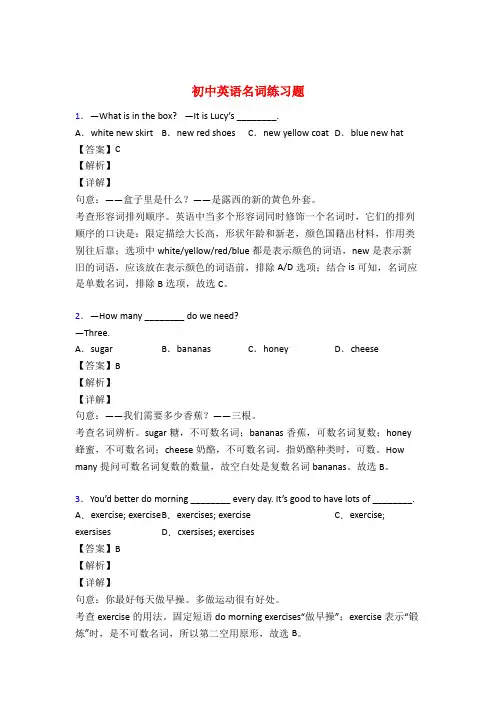
初中英语名词练习题1.—What is in the box?—It is Lucy’s ________.A.white new skirt B.new red shoes C.new yellow coat D.blue new hat 【答案】C【解析】【详解】句意:——盒子里是什么?——是露西的新的黄色外套。
考查形容词排列顺序。
英语中当多个形容词同时修饰一个名词时,它们的排列顺序的口诀是:限定描绘大长高,形状年龄和新老,颜色国籍出材料,作用类别往后靠;选项中white/yellow/red/blue都是表示颜色的词语,new是表示新旧的词语,应该放在表示颜色的词语前,排除A/D选项;结合is可知,名词应是单数名词,排除B选项,故选C。
2.—How many ________ do we need?—Three.A.sugar B.bananas C.honey D.cheese【答案】B【解析】【详解】句意:——我们需要多少香蕉?——三根。
考查名词辨析。
sugar糖,不可数名词;bananas香蕉,可数名词复数;honey 蜂蜜,不可数名词;cheese奶酪,不可数名词,指奶酪种类时,可数。
How many提问可数名词复数的数量,故空白处是复数名词bananas。
故选B。
3.You’d better do morning ________ every day. It’s good to have lots of ________. A.exercise; exercise B.exercises; exercise C.exercise; exersises D.cxersises; exercises【答案】B【解析】【详解】句意:你最好每天做早操。
多做运动很有好处。
考查exercise的用法。
固定短语do morning exercises“做早操”;exercise表示“锻炼”时,是不可数名词,所以第二空用原形,故选B。
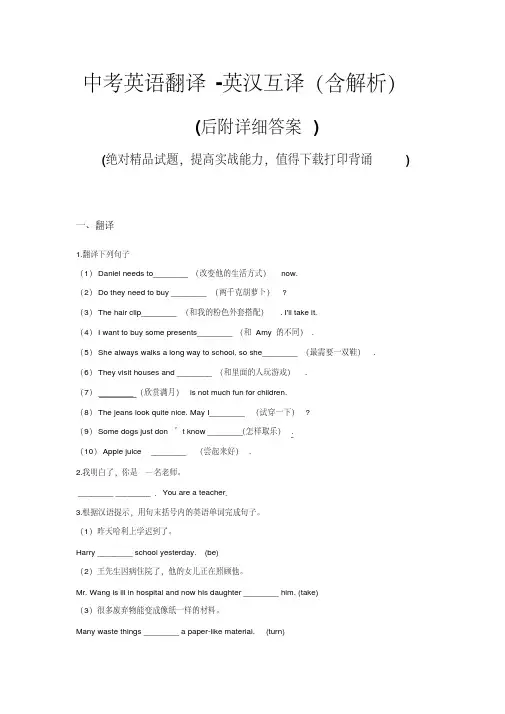
中考英语翻译-英汉互译(含解析)(后附详细答案)(绝对精品试题,提高实战能力,值得下载打印背诵)一、翻译1.翻译下列句子(1)Daniel needs to________ (改变他的生活方式)now.(2)Do they need to buy ________ (两千克胡萝卜)?(3)The hair clip________ (和我的粉色外套搭配). I'll take it.(4)I want to buy some presents________ (和Amy的不同).(5)She always walks a long way to school, so she________ (最需要一双鞋).(6)They visit houses and ________ (和里面的人玩游戏).(7)________ (欣赏满月)is not much fun for children.(8)The jeans look quite nice. May I________ (试穿一下)?(9)Some dogs just don’t know ________(怎样取乐).(10)Apple juice ________ (尝起来好).2.我明白了,你是—名老师。
________ ________ .You are a teacher.3.根据汉语提示,用句末括号内的英语单词完成句子。
(1)昨天哈利上学迟到了。
Harry ________ school yesterday. (be)(2)王先生因病住院了,他的女儿正在照顾他。
Mr. Wang is ill in hospital and now his daughter ________ him. (take)(3)很多废弃物能变成像纸一样的材料。
Many waste things ________ a paper-like material. (turn)(4)我只好告诉你真相,那位作家已经把大部分钱捐给了慈善组织。
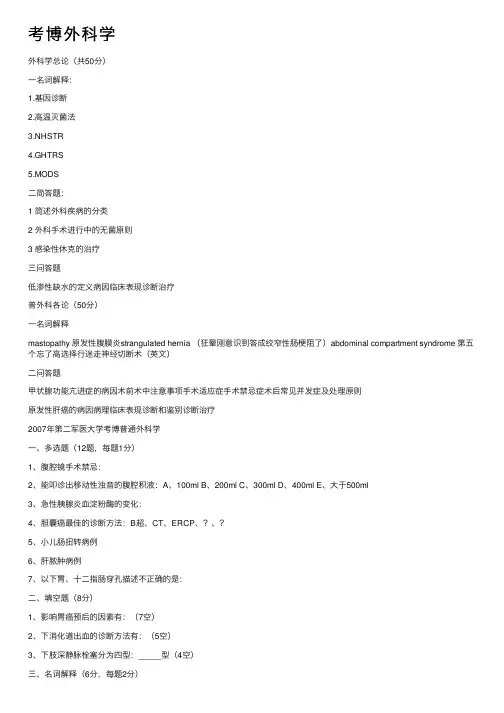
考博外科学外科学总论(共50分)⼀名词解释:1.基因诊断2.⾼温灭菌法3.NHSTR4.GHTRS5.MODS⼆简答题:1 简述外科疾病的分类2 外科⼿术进⾏中的⽆菌原则3 感染性休克的治疗三问答题低渗性缺⽔的定义病因临床表现诊断治疗普外科各论(50分)⼀名词解释mastopathy 原发性腹膜炎strangulated hernia (狂晕刚意识到答成绞窄性肠梗阻了)abdominal compartment syndrome 第五个忘了⾼选择⾏迷⾛神经切断术(英⽂)⼆问答题甲状腺功能亢进症的病因术前术中注意事项⼿术适应症⼿术禁忌症术后常见并发症及处理原则原发性肝癌的病因病理临床表现诊断和鉴别诊断治疗2007年第⼆军医⼤学考博普通外科学⼀、多选题(12题,每题1分)1、腹腔镜⼿术禁忌:2、能叩诊出移动性浊⾳的腹腔积液:A、100ml B、200ml C、300ml D、400ml E、⼤于500ml3、急性胰腺炎⾎淀粉酶的变化:4、胆囊癌最佳的诊断⽅法:B超、CT、ERCP、?、?5、⼩⼉肠扭转病例6、肝脓肿病例7、以下胃、⼗⼆指肠穿孔描述不正确的是:⼆、填空题(8分)1、影响胃癌预后的因素有:(7空)2、下消化道出⾎的诊断⽅法有:(5空)3、下肢深静脉栓塞分为四型:_____型(4空)三、名词解释(6分,每题2分)1、buerger病2、charcot 综合征3、TME四、问答题1、家族性结肠息⾁病的发病原理、诊断、⼿术⽅式、术后随访原则?(20分)2、甲亢术后并发症及处理?(24分)3、肠梗阻按梗阻原因的分类;肠梗阻的治疗原则以及⾮⼿术治疗⽅法?(30分)第三军医⼤学2013博⼠普外专业⼀、名词解释1、richer疝2、倾倒综合征(英⽂)3、布加综合征(英⽂)4、⼆、简答题1、乳腺癌根治术切除范围2、胰腺癌⼿术切除范围3、简述直肠癌超低位保肛术4、chiold分级及其临床意义三、问答题1、急性梗阻性黄疸治疗原则2、论述胃癌外科治疗的最新进展2013南京医科⼤学普外科学(总论+普外)考博真题回忆版简答4分*61、创伤组织修补基本过程?2、30秒内确定⼼搏骤停的⽅法?3、输⾎后常见并发症?4、低钾的常见病因?5、营养⽀持⽅法选择原则?6、⼿术中的⽆菌原则?问答19分*41、胰腺假性囊肿的⼿术指征、⽅式、要点?2、甲状腺⼿术并发症及治疗?3、腹膜后⼗⼆指肠破裂诊断依据及治疗?4、完善的科研设计标志有哪些?第三军医⼤学2013年外科专业基础之⼈体解剖真题名词解释:胸⾻⾓纵隔膜迷路动脉韧带肺段简答脑屏障的主要特点喉的结构,运动及功能的关系胆汁的产⽣,排出的主要特点问答⽪质核束的主要特点内脏传导通路的主要特点迷⾛神经的主要特点腰丛的主要特点2013中⼭⼤学博⼠⽣⼊学考试(普外)1糖⽪质激素外科感染性休克2糖尿病围术期准备要点3开放⽓胸处理原则4影像学在泌尿系结⽯的诊断应⽤5胃癌腹腔镜禁忌6胆管囊性扩张的分型7下肢静脉体格检查名称8外科真菌感染因素和抗真菌药物9切⼝裂开预防10⿊⾊素瘤的临床表现11CEA.AFP.CA199.CA125.PSA,中⽂名称及诊断价值12门脉⾼压⾮⼿术治疗及贲门⾎管离断理由13 低渗性缺⽔的原因14乳腺癌分⼦分型及治疗建议15胃癌根治原则,根治划分,远端胃癌根治切除范围16慢性胰腺炎⼿术指征,⼿术原则,⼿术⽅式。
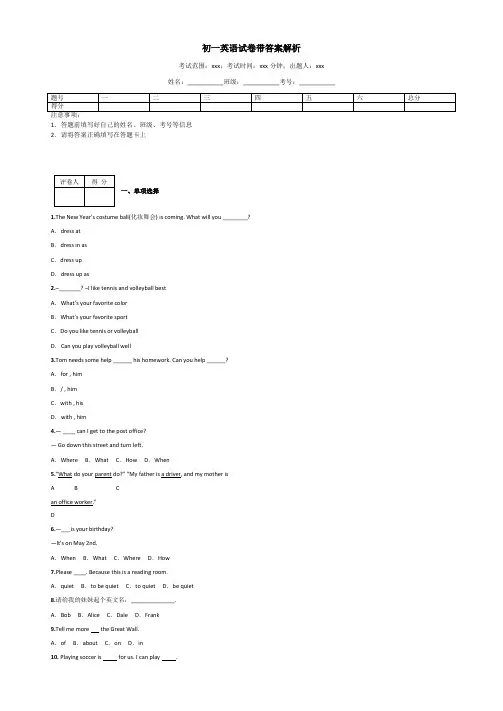
初一英语试卷带答案解析考试范围:xxx;考试时间:xxx分钟;出题人:xxx姓名:___________班级:___________考号:___________1.答题前填写好自己的姓名、班级、考号等信息2.请将答案正确填写在答题卡上一、单项选择1.The New Year’s costume ball(化妆舞会) is coming. What will you ________?A.dress atB.dress in asC.dress upD.dress up as2.–_______? –I like tennis and volleyball bestA.What’s your favorite colorB.What’s your favorite sportC.Do you like tennis or volleyballD.Can you play volleyball well3.Tom needs some help ______ his homework. Can you help ______?A.for , himB./ , himC.with , hisD.with , him4.— ____ can I get to the post office?— Go down this street and turn left.A.Where B.What C.How D.When5.“What do your parent do?” “My father is a driver, and my mother isA B Can office worker.”D6.—___is your birthday?—It's on May 2nd.A.When B.What C.Where D.How7.Please ____. Because this is a reading room.A.quiet B.to be quiet C.to quiet D.be quiet8.请给我的妹妹起个英文名:______________.A.Bob B.Alice C.Dale D.Frank9.Tell me more the Great Wall.A.of B.about C.on D.in10. Playing soccer is for us. I can play .A.good; goodB.well; goodC.good; wellD.well; well二、单词拼写根据中文提示或者单词首字母,写出单词的正确形式。
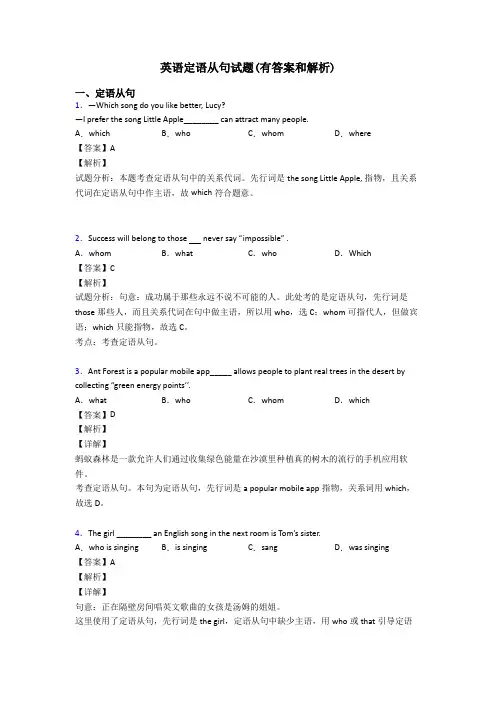

abdominalaorta腹主动脉Accessorynerve副神经Adductor longus 长收肌Adductor magnus 大收肌Adductorpollicis拇收肌adductor收肌管anorectalring肛直肠环Ansacervicalis颈襻Anteriortibial胫前动脉Aorticarch主动脉弓appendicularartery阑尾动脉Axillary fossa腋窝Axillary sheath腋鞘axillaryartery腋动脉axillaryLymph nodes腋淋巴结axillarynerve腋神经Azygo奇静脉sBasilicavein贵要静脉Biceps brachii 肱二头肌Brachial plexus 臂丛Brachialis 肱肌Brachiocephalicvein头壁静脉Brachioradialis 肱桡肌broadligamentofuterus子宫阔韧带cardinalligamentofuterus子宫主韧带Carotid triangle 颈动脉三角Carpal腕管cecum盲肠celiactrunk腹腔干Cephalicvein头静脉Cervical part of sympathetic trunk 颈交感干Cervical plexus 颈丛Circumflex scapularartery旋肩胛动脉Clavipectoral fascia锁胸筋膜Common interosseousartery骨间总动脉Common peronealnerve腓总神经commonbileduct胆总管commoncarotidartery颈总动脉commoniliacartery髂总动脉Coracobrachialis 喙肱肌Costodiaphragmaticrecess肋隔隐窝Cubital fossa 肘窝Cupula of pleura 胸膜顶cysticartery胆囊动脉Deeppalmar掌深弓Deltoid三角肌dentalline齿状线Digastric 二腹肌dorsalscapularartery肩胛背动脉Endothoracicfascia胸内筋膜Epicranial aponeurosis帽状腱膜epiduralspace硬膜外隙erectorspinae竖脊肌externalcarotidartery颈外动脉externaliliacartery髂外动脉Facialartery面动脉Facialnerve面神经Femoral triangle股三角Femoralartery股动脉Femoralcanal股管Femoralring股环Femoralsheath股鞘Flexor carpi ulnaris 尺侧腕屈肌Flexor pollicis longus 坶长屈肌gallbladder胆囊Gastronemius 腓肠肌Gluteus maximus 臀大肌Gracilis 股薄肌greateroccipitalnerve枕大神经greatsaphenous大隐静脉hepaticpedicle肝蒂hepaticportalvein肝门静脉Hilumoflung肺门Humeromuscular tunnel 肱骨肌管Hypoglossalnerve舌下神经ilealartery回肠动脉ileocolicartery回结肠动脉iliohypogastricnerve髂腹下神经ilioinguinalnerve髂腹股沟神经Inferiorglutealnerve臀下神经inferiorvenacava下腔静脉Infraorbitalnerve眶下神经Infraspinatus冈下肌inguinalcanal腹股沟管inguinaltriangle腹股沟三角Intercostalesexterni肋间外肌Intercostalnerves肋间神经Intercostalsinterni肋间内肌Intercostalsspace肋间隙Internal jugular v. 颈内静脉Internal pudentalartery阴部内动脉Internal thoracicartery胸阔内动脉internaliliacartery髂内动脉ischiorectalfossa坐骨直肠窝jejunalartery空场动脉Lateral pectoralnerve胸外侧神经Latissimusdorsi背阔肌leftgastricartery胃左动脉leftgastroepipoic胃网膜左动脉lesseromentum小网膜levatorani冈提肌ligamentaflava黄韧带lumbarplexus腰丛Malleolar canal 踝管Masseter 咬肌Median cubitalvein肘正中静脉Median.nerve正中神经Mediastinum纵隔mesentery肠系膜Midpalmarspace掌中间隙Musculartriangle肌三角Musculocutaneousnerve肌皮神经obliquusexternusabdominis腹外斜肌obliquusinternusabdominis腹内斜肌obturatorartery闭孔动脉obturatornerve闭孔神经Occipital triangle 枕三角occipitalartery枕动脉omentalbursa网膜囊Omoclaviculartriangle肩胛舌骨肌锁骨三角Opponenspollicis拇对掌肌ovary卵巢Parathyroid gland 甲状旁腺Parietalpleura壁胸膜Parotid gland 腮腺Pectoralis major 胸大肌pelvicdiaphragm盆隔pelvicfascia盆筋膜pelvirectalspace骨盆直肠间隙penis阴茎Pericardialcavity心包腔Pericardium心包perinealcentraltendon会阴中心腱peritonealcavity腹膜腔peritoneum腹膜Pervertebral space 椎前间隙Phrenic n. 膈神经Piriformis梨状肌Pleuralcavity胸膜腔Popliteal fossa 腘窝portahepatis肝门Posterior humeral circumflexartery旋肱后动脉Posteriorintercostalarteries肋间后动脉Posterior股间后动脉Pronator teres 旋前圆肌properhepaticartery肝固有动脉pudendalcanal阴部管Pudendalnerve阴部神经Quadricepsfemoris股四头肌Quadrilateralspace四边间隙Radialnerve桡神经rectputerinepouch直肠子宫陷凹rectusabdominis腹直肌Recurrent laryngealnerve喉返神经renalartery肾动脉retroperionealspace腹膜后间隙retropubicspace耻骨后隙retrorectalspace直肠后隙rightcolicartery右结肠动脉Rightlymphaticduct右淋巴导管Rootoflung肺根Sartorius缝匠肌Scalenus anterior 前斜角肌Sciatic n. 坐骨神经scrotum阴囊Semimembranosus 半膜肌Semitendinosus半腱肌sheathofrectusabdominis腹直肌鞘sigmoidartery乙状结肠动脉Soleus比目鱼肌sperior膀胱上动脉spermaticcord精索sphincteraniexternus肛门外阔约肌splenicartery脾动脉Sternocleidomastoid 胸锁乳突肌subarachnoidspace蛛网膜下隙Subclavianartery 锁骨下动脉Submandibular triangle 下颌下三角Submandibulargland下颌下腺Submental triangle 刻下三角suboccipitaltriangle枕下三角Subscapularis肩胛下肌Subscapularnerve肩胛下神经supeiorepigastricartery腹壁上动脉Superficial temporalartery.颞浅动脉superficialperinealspace会阴浅隙Superior cervical ganglion 颈上神经节superiorglutealartery臀上动脉superiorglutealnerve臀上神经Superiorlaryngealnerve喉上神经superiorlumbartriangle腰上三角superiormesentericartery肠系膜上动脉superiorrectalartery直肠上动脉Superiorthyroidartery甲状腺上动脉Superiorvenacava上腔静脉Supinator旋后肌Supraorbitalnerve眶上神经suprarenalgland肾上腺Suprascapularartery肩胛上动脉Supraspinatus冈上肌Teresminor小圆肌terminalcistern终池Thenarspace鱼际间隙Thenar鱼际Thoracic duct 胸导管Thoracicaorta胸主动脉Thoracicduct胸导管Thoracoacromialartery胸肩峰动脉Thoracodorsalnerve胸背神经thoracolumbarfascia胸腰筋膜Thymus胸腺Thyroid gland 甲状腺Tibalisanterior胫骨前肌Tibialnerve胫神经transversefascia腹横筋膜Transversesinusofpericardium心包横窦transversusabdominis腹横肌Trapezius斜方肌Tricepsbrachii肱三头肌Trilateralspace三边间隙Ulnarverve尺神经ureter输尿管urinarybladder膀胱urogenitaldiaphragm尿生殖隔uterineartery子宫动脉uterinetube输卵管uterus前列腺Vagusnerve迷走神经vermiformappendix阑尾Vertebralartery椎动脉vertebralcanal椎管vesicouterinepouch膀胱子宫陷凹Visceralpleura脏胸膜。
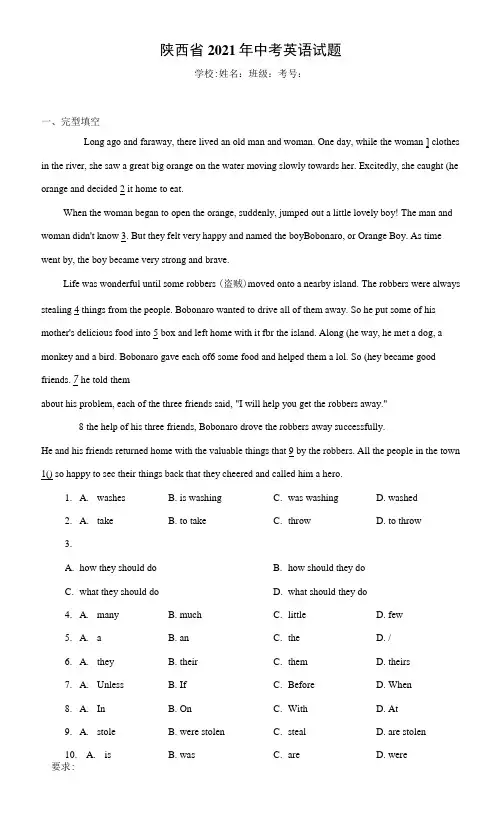
陕西省2021年中考英语试题学校:姓名:班级:考号:一、完型填空Long ago and faraway, there lived an old man and woman. One day, while the woman ] clothes in the river, she saw a great big orange on the water moving slowly towards her. Excitedly, she caught (he orange and decided 2 it home to eat.When the woman began to open the orange, suddenly, jumped out a little lovely boy! The man and woman didn't know 3. But they felt very happy and named the boyBobonaro, or Orange Boy. As time went by, the boy became very strong and brave.Life was wonderful until some robbers (盗贼)moved onto a nearby island. The robbers were always stealing 4 things from the people. Bobonaro wanted to drive all of them away. So he put some of his mother's delicious food into 5 box and left home with it fbr the island. Along (he way, he met a dog, a monkey and a bird. Bobonaro gave each of6 some food and helped them a lol. So (hey became good friends. 7 he told themabout his problem, each of the three friends said, "I will help you get the robbers away."8 the help of his three friends, Bobonaro drove the robbers away successfully.He and his friends returned home with the valuable things that 9 by the robbers. All the people in the town 1() so happy to sec their things back that they cheered and called him a hero.1. A. washes B. is washing C. was washing D. washed2. A. take B. to take C. throw D. to throw3.A. how they should doB. how should they doC. what they should doD. what should they do4. A. many B. much C. little D. few5. A. a B. an C. the D. /6. A. they B. their C. them D. theirs7. A. Unless B. If C. Before D. When8. A. In B. On C. With D. At9. A. stole B. were stolen C. steal D. are stolen10. A. is B. was C. are D. were要求:1.参考表格提示内容,可适当发挥;2.语句通顺,意思连贯,书写工整;3.文章不得出现你的任何真实信息(姓名、校名和地名等);4.词数:不少于70词。
初中英语名词练习题1.After watching two lessons, our parents will go to the ________ to have a meeting.A.dining hall B.reading room C.school hall D.library【答案】C【解析】【详解】句意:看了两节课后,我们的父母将去学校礼堂开会。
考查名词。
dining hall餐厅;reading room阅览室;school hall学校礼堂;library 图书馆。
根据句中的“to have a meeting”以及常识可知,开会要到学校礼堂去。
故选C。
2.Thank you for ________.A.help B.helping C.your help【答案】C【解析】【分析】【详解】句意:谢谢你的帮忙。
考查固定句型。
thank sb. for doing sth.或thanks for sth.为固定搭配,意为“感谢某人做某事”或“感谢某人某事”,A选项为动词原形,不符合句子结构,可排除。
B选项后应接宾语,可排除,故选C。
3.There are four________ and two________ at the________.A.Johns; Marys; doctors B.Johns; Marys; doctor’s C.John’s; Mary’s; doctor’s D.John; Mary; doctor’s【答案】B【解析】【详解】句意:在医务室里有四个约翰和两个玛丽。
考查名词的数和所有格。
根据four及two可知,应用名词复数。
“the doctor’s”表示“诊所或医务室”。
故选B。
4.How many ________ are there in the international village?A.Chinese B.Russian C.American D.German【答案】A【解析】【详解】句意:国际村里有多少中国人?考查名词辨析。
局解机考考点VERSION 1.2.4(黄色部分为名词解释,最后附英文单词表)头部·头皮层次额顶枕区颞区皮肤皮肤浅筋膜浅筋膜帽状腱膜及枕额肌颞浅筋膜腱膜下疏松组织颞深筋膜颞肌颅骨外膜颅骨外膜枕区浅部三层紧密连接难以镊子分开,合称头皮,深部两层连接疏松,容易分离。
·翼点:翼点:是额骨、顶骨、颞骨和蝶骨大翼4骨相交处所形成的“H”形骨缝,位于颞窝内,颧弓中点上方两横指(或3.5~4cm)处,此处骨质菲薄,内有脑膜中动脉(穿棘孔入脑)前支通过,此处受暴力打击易骨折,骨折易损伤血管形成硬膜外血肿。
颈部:(颈部浅筋膜包含了颈阔肌)名词解释1. 封套筋膜(又称颈筋膜浅层)(superficial layer of cervical fascia)·该筋膜上方附于头颈分界线,下方附于颈与胸部和上肢的分界处,,后方附于项韧带和第七颈锥棘突。
·分层包绕斜方肌和胸锁乳突肌分别形成斜方肌肌鞘和胸锁乳突肌肌鞘在正中线上两侧相延续,形成包裹整个颈部的封套层。
还在舌骨上部分层包裹二腹肌前腹和下颌下腺,在面后部包裹腮腺,分别形成下颌下腺囊和腮腺囊(注:形成两个肌鞘和两个囊)2. 下颌下三角(submandibular triangle)·境界下颌下三角位于下颌骨下缘与二腹肌前、后腹之间·此三角浅面有皮肤、浅筋膜、颈阔肌和颈筋膜浅层,深面由浅入深依次为下颌舌骨肌、舌骨舌肌及咽中缩肌·内容:下颌下腺,面动脉,面静脉,下颌下淋巴结,舌神经和舌下神经3. 颈动脉三角(carotid triangle)·境界胸锁乳突肌上份前缘、肩胛舌骨肌上腹和二腹肌后腹之间。
·其浅面为皮肤、浅筋膜、颈阔肌及颈筋膜浅层;深面为椎前筋膜;内侧为咽侧壁及其筋膜。
·内容:颈总动脉及其分支,颈内静脉及其属支,舌下神经及颈襻上根,迷走神经及其分支,和颈深淋巴结4.肌三角(muscular triangle)(甲状腺区)·境界:由颈前正中线,胸锁乳突肌,肩胛舌骨肌上腹围城·层次:皮肤,浅筋膜,颈筋膜浅层(没有颈阔肌),深面为椎前筋膜·内容:舌骨下肌群,甲状腺和甲状旁腺,气管颈部,相关的血管神经(甲状腺上,下动脉,最下动脉(可能),上中下静脉,喉返,喉上神经4. 枕三角(occipital triangle)·境界:胸锁乳突肌后缘,肩胛舌骨肌下腹上缘,斜方肌前缘·颈筋膜浅层构成该三角的顶,颈筋膜深层和深层肌(头夹肌,肩胛提肌,前中后斜角肌)构成该三角的底·内容:副神经,颈丛和臂丛的分支5. 锁骨上三角(supraclavicular triangle)·境界:胸锁乳突肌后缘,肩胛舌骨肌下腹和锁骨中段1/3上缘·内容,锁骨下动静脉,和臂丛6. 气管·气管位置、毗邻以及切开术时需切开层次:答: 1.位置:上平第6颈椎体下缘接环状软骨下缘,下方前面平胸骨颈V 切迹,后面平第7颈椎体下缘移行为气管胸部。
九门学科试题及答案解析一、语文试题及答案解析1. 试题:请解释“天行健,君子以自强不息”的含义。
答案:这句话出自《周易》,意思是天道运行不息,君子应当效仿天道,不断自我提升,努力不懈。
解析:此题考查学生对经典文献的理解能力,要求学生能够准确把握句子的含义,并能够联系实际生活进行解读。
2. 试题:请分析《红楼梦》中林黛玉的性格特点。
答案:林黛玉性格多愁善感,聪明机智,同时又带有一些孤傲和自卑。
解析:此题考查学生对文学作品中人物性格的分析能力,要求学生能够结合文本内容,对人物性格进行深入的剖析。
二、数学试题及答案解析1. 试题:已知函数f(x) = 2x^2 - 3x + 1,求f(2)的值。
答案:f(2) = 2(2)^2 - 3(2) + 1 = 8 - 6 + 1 = 3。
解析:此题考查学生对函数求值的计算能力,要求学生能够熟练运用代入法求解函数值。
2. 试题:解方程x^2 - 5x + 6 = 0。
答案:x = 2 或 x = 3。
解析:此题考查学生解一元二次方程的能力,要求学生能够熟练运用因式分解法求解方程。
三、英语试题及答案解析1. 试题:请将下列句子翻译成英文:“他每天早晨都去公园跑步。
”答案:He goes running in the park every morning.解析:此题考查学生对英语句子的翻译能力,要求学生能够准确把握句子的意思,并能够用正确的语法结构进行翻译。
2. 试题:请用英文解释“Global warming”的含义。
答案:Global warming refers to the long-term increase in Earth's average surface temperature due to human activities, such as the burning of fossil fuels.解析:此题考查学生对专业术语的英文解释能力,要求学生能够准确理解并用英文表达专业术语的含义。
(英语)中考英语冠词试题经典及解析一、初中英语冠词1.Hurry up! The concert will begin in_________ minute.A. aB. anC. theD. /【答案】A【解析】【分析】句意:快点,音乐会马上就要开始了。
in a minute固定词组,马上、立刻,故答案为A。
【点评】考查冠词的用法,牢记固定搭配。
2.— Do you know how to spell word “expensive” in English?— Yes. It begins with "e".A. the; aB. the; anC. a; anD. the; the【答案】 B【解析】【分析】句意:——你知道如何用英语拼写单词“昂贵的”吗?——是的,它是以一个字母e开始。
第一句话特指expensive这个单词,应使用定冠词the,第二句指的是一个字母e,应使用不定冠词,e为元音使用an,故答案是B。
【点评】考查冠词用法,注意表示特指使用定冠词the,表示数量已使用不定冠词。
3.Bill bought ________ useful book. ________ book is very interesting.A. a; TheB. a; AC. an; TheD. an; A【答案】 A【解析】【分析】句意:Bill买了一本有用的书。
这本书很有趣。
表示泛指一本有用的书,且useful以辅音音素开头,用不定冠词a,第二次出现book,表特指,用the,故选A。
【点评】考查冠词的用法。
注意定冠词和不定冠词的用法。
4.—Look! Who's ________ girl in a red skirt over there?—Oh, she is my sister, Kate. She is ________ honest girl.A. that; aB. this; theC. this; aD. that; an【答案】 D【解析】【分析】句意:——看,那边穿红色裙子的那个女孩是谁?——哦,她是我姐姐,她是一个诚实的女孩。
【英语】初中英语定语从句及其解题技巧及练习题(含答案)含解析一、定语从句1.This is the bike_______I lost last week.A.that B.what C.who D.whose【答案】A【解析】试题分析:句意:这是我上周丢失的那辆自行车。
此句是一个定语从句。
bike为先行词,当先行词为物时,引导词应该用that/which,故答案为A。
考点:考查定语从句。
2.Music is the only thing ______ can help me to relax after a long day of hard work. A.which B.that C.who【答案】B【解析】【详解】句意:音乐是可以在努力工作的一天后,帮助我放松的唯一一件事。
which修饰事物,引导定语从句;that修饰事物,引导定语从句;who修饰人,引导定语从句。
此处修饰先行词thing,有the only修饰,故用that引导定语从句。
故选B。
3.When we speak of culture, we mean a way of life_________ a group of people have in common.A.what B.who C.where D.that【答案】D【解析】【详解】句意:当我们说起文化的时候,我们指的是一群人共同拥有的生活方式。
考查定语从句的引导词。
根据句意:当我们说起文化的时候,我们指的是一群人共同拥有的生活方式。
逗号后面的句中是含有定语从句的复合句,先行词是 life,表示“物”,用引导词 that,在从句中做宾语。
what 不能引导定语从句。
先行词是“人”,引导词常用 who。
where 在定语从句中做地点状语。
故选D。
【点睛】引导定语从句的关联词包括关系代词和关系副词。
关系代词有that, which, whose, who, whom, as;关系副词有when, where, why。
局解试题英文文件排版存档编号:[UYTR-OUPT28-KBNTL98-UYNN208]Pelvic and perineumSingle-choice questions1.The bony pelvis (A)A.is formed by the two hip bones, sacrum, coccyx and theirjoints.B.can be divided into abdominal and pelvic part by the terminalline.C.is enclosed at the inferior pelvic aperture by perineum.D.is wider, shorter and more funnel-shaped in female than inmale.E.pelvic outlet is formed by the terminal line.2.The levator ani does not include (A)A.coccygeus.B.levator prostate.C.puborectalis.D.pubococcygeus.E.iliococcygeus.3.The pelvic diaphragm (E)A.encloses the whole inferior aperture of the pelvis.B.is located in the anal triangle.C.consists of levator ani, sphincter ani externus, superior andinferior fascia of pelvic diaphragm.D.has a hiatus of pelvic diaphragm for digestive and urogenitalcanal.E.can support the pelvic viscera.4.The perineum (B)A.is all of the soft tissue enclosing pelvic inlet.B.can be divided into urogenital and anal region.C.ends anteriorly at the external reproductive organsD.ends posteriorly at the anus.E.is a triangle-shaped region.5.The hiatus of the pelvic diaphragm(A)A.is a cleft between the anteromedial margin of pelvic diaphragm.B.is filled with the urogenital diaphragm.C.is enclosed by superior and inferior fascia of urogenitaldiaphragm.D.is the main channel connecting the pelvic spaces and perinealspace.E.is penetrated by the membranous part of the urethra in male.6.The retropubic space (B)A.is located between the urinary bladder and rectum or uterus.B.is usually used for extra-peritoneal operation of urinarrybladder.C.is rich in venous plexus and unsuitable for organ separation.D.is suitable for exudation absorption.E.doesn’t communicating with other pelvic spac es7.The retrorectal space (E)A.surround the inferior part of the ampulla of rectum.B.is the space between the sacrum and presacral fascia.C.is rich in venous plexus and unsuitable for rectus separation.municates downwards with the ischioanal fossa.municates upwards with the retroperitoneal space .8.Which one is right about the rectum (D)A.It continues upwards with the sigmoid colon at the level ofpelvic inlet.B.It continues downwards with the anal canal at the level ofdentate line.C.The upper part is not covered by peritoneum.D.It has sacral and perineal flexures in the sagittal plane.E.It is a intraperitoneal viscera.9.Concerning Hilton’s line,the the wrong description is (E)A.lies at the interval between the sphincter ani internus andexternus.B.is about 1cm below the dentate line.C.is also called white line.D.is continuous upwards with the anal pecten.E.can not be felt in digital examination of the anal canal.10.Which one is wrong about the relations of the rectum (B)A.The sacral plexus is behind it.B.It is separated from the prostate by rectovesical pouche inmale.C.It is separated from the seminal vesicle by rectovesicalpouche in male.D.It is separated from uterus by rectouterine pouch in female.E.It is separated from the vagina by rectouterine pouch andfascial septum in female.11.Through the anterior wall of the rectum , we can not palpate(E)A.prostate.B.seminal vesicle.C.ampulla ductus deferentis.D.neck of uterus.E.urethra.12.The urinary bladder (E)A.may raised into the peritoneal cavity when it is filled withurine.B.contacts with prostate posteriorly (male).C.contacts with posterior part of fornix of vagina (female).D.contacts with the urogenital diaphragm at the apex.E.is entirely within the lesser pelvis when it is empty13.T he mark to find the uriteric orifice in urinary bladder is (C)A.trigone of bladder.B.internal urethral orifice.C.interureteric fold.D.urethral ridge.E.vesical uvula.14.The pelvic part of ureter (D)A.descends immediately behind the internal iliac artery.B.crosses lateral to the external vessels, umbilical artery,obturator nerve and vessels.C.crosses posteriorly over the ductus deferens (male).D.passes lateral to the fornex of the vagina and is crossed byuterine artery.E.ends on the inferior of the urinary bladder as the internalurethral orifice.15.The prostate (A)A.is located between the apex of bladder and urogenitaldiaphragm.B.is placed in front of the uterus.C.has venous plexus between the prostatic capsule and sheath.D.can not be touched during check-up.E.is pierced by the ductus deferens.16.Which one is wrong about the prostate(C)A.It is a chestnut-shaped organ.B.It may be divided into anterior, middle, posterior and twolateral lobes.C.The urethra passes through the middle lobe of the gland.D.There is prostatic sulcus along the middle line on theposterior surface.E.The ejaculatory duct penetrates the base and opens on seminalcolliculus.17.Which one is wrong about the uterus (D)A.It can be divided into three parts-fundus, body and neck.B.The isthmus is a slight constriction at the junction betweenthe neck and body.C.The lower part of the neck can insert into the vagina.D.The cavity in the uterus is called cavity of uterus.E.The body is bent forward at the junction with the neck(anteflection).18.Which one is wrong about the uterine artery (E)A.It arises from the internal iliac artery.B.It descends in front of the ureter to the base of broadligament.C.It crosses above the ureter just lateral to the neck of theuterus.D.It sends branches to vagina, uterine tube and ovary.E.It should be protected during hysterectomy (子宫切除术).19.The ligaments that protect the uterus from prolapse is(下垂)(D)A.broad ligament of uterus.B.suspensory ligament of ovary.C.round ligament of uterus.D.cardinal ligament of uterus.E.uterosacral ligament.20.Which one is wrong about the position of the uterus (D)A.Its inferior end is above the ischial spine.B.The urinary bladder is in front of it.C.The uterine tube, ovaries, broad ligament are on both sides ofit.D.The rectum is behind it.E.Its lower part penetrates the urogenital diaphragm.21.The ovary (E)A.is situated in the ovary fossa between the common and internalartery.B.is a retroperitoneal viscera.C.is connected to the uterus by proper ligament of ovary at itssuperior extremity.D.is attached to the front of the broad ligament of uterus bymesoovarium.E.is suspended to the pelvic wall by suspensory ligament ofovary.22.Fertilization(受精) usually occures in (D)A.cavity of uterus.B.uterine part of uterine tube..C.isthmus of uterine tube.D.ampulla of uterine tube.E.infundibulum of uterine tube.23.Which one is wrong about the uterine tube (D)A.It is situated on the upper margins of the broad ligament ofuterus.B.Its medial end opens into the cavity of uterus by uterineorifice.C.Its lateral end open into peritoneal cavity by abdominalorifice.D.It can be divided into three part: isthmus, ampulla, andinfundibulum.E.It is usually distinguished from the small intestine byfimbriae.24.Which one is wrong about the vagina (B)A.The upper end surrounds the lower part of neck of uterus.B.The anterior wall is longer than the posterior one.C.The posterior fornix of vagina is near the rectouterine pouch.D.The anterior wall contacts with urinary bladder and urethra.E.The posterior wall contacts with the anterior wall of rectum.25.Anal canal (A)A.continues with the rectum at the level of pelvic diaphragm.B.terminates at the dentate line.C.is about 7~8 cm in length.D.has two flexures in sagittal plane.E.has a dilated upper part called ampulla of rectum.26.Below the dentate line (E)A.The epidermis is skin.B.The epidermis is innervated by somatic nerve.C.The lymph is drained into the superficial inguinal lymph node.D.The blood is drained into the internal iliac vein.E.All of the above are is right.27.The ischioanal fossa (D)A.is located between the rectum and ischium.municates anteriorly with the superficial perineal space.municates posteriorly with the gluteal region throughgreater sciatic foramen.D.has pudendal canal on its lateral wall.E.is traversed by the obturator nerve.28.The pudendal canal (E)A.runs in the center of the ischioanal fossa.B.is a cleft formed by superior fascia of pelvic diaphragm.municates with the obturator canal.municates with the greater sciatic foramen.E.contains the pudendal nerve and internal pudendal vessels.29.Superficial fascia of perineum (C)A.can be divided into two layers.B.extends backwards with the superficial fascia in anal region.C.continues with Scarpa’s fascia.D.is not joined with the deep fascia of perineum.E.is separated from the inferior fascia of pelvic diaphragm withsuperficial perineal space.30.Which one is wrong about the deep fascia of perineum (E)A.It can be divided into two layers.B.It attaches laterally to the pubic arches.C.It attaches posteriorly to the line between the ischialtuberosities.D.It encloses the deep perineal space.E.It is also called Colles’ fascia.31.The superficial perineal space does not contain (E)A.suferficial transverse muscle of peritoneum.B.crura of penis.C.ischiocavernosus or bulbocavernous.D.bulb of urethra (male).E.bulbourethral gland.32.The deep perineal space does not contain (E)A.membranous part of urethra.B.sphincter of urethra.C.bulbourethral gland.D.deep transverse muscle of perineum.E.bulb of vestibule33.Which space is enclosed (B)A.superficial perineal spaceB.deep perineal spaceC.retropubic spaceD.retrorectal spaceE.ischioanal fossa34.The internal spermatic fascia is continuous with(E)A.scarpa’s fascia.B.aponeurosis of obliquus externus abdominis.C.aponeurosis of obliquus internus abdominis.D.aponeurosis of transversus abdominis.E.transverse fascia.35.Which muscle does not insert to the perineal central tendon(C)A.superficial transverse muscle of perineum.B.deep transverse muscle of perineum.C.ischiocavernousus.D.bulbocavernousus.E.urethrovaginal sphincter36.Which one is wrong about the perineum in female in narrowsense.(D)A.It is located between the external reproductive organs and theanus.B.It contains the perineal central tendon.C.It is easier tore up during childbirth.D.It is poor developed in female.E.It is also called obstetrical perineum.37.Which one is not the important surface landmark (E)A.pubic crest.B.pubic arch.C.ischial tuberosity.D.apex of coccyx.E.promontory of the sacrum.38.Which is wrong about the internal iliac artery (D)A.It arises from the common artery.B.It is a short trunk descending into the lesser pelvis.C.The ureter runs anterior to it.D.Send out the inferior epigastric a.E.The internal iliac vein accompanies the artery on its medialside.39.The internal iliac artery doesn’t send(D)A.superior gluteal artery.B.obturator artery.C.internal pudendal artery.D.superior rectal artery.E.inferior vesical artery.40.Which is wrong about the nervous plexus in the pelvis (C)A.The sacral plexus lies in front of the piriformis.B.The sacral sympathetic trunk runs medial to the anteriorsacral foramen.C.The sacral plexus belong to the syspathetic n.D.The pelvic plexus is also called inferior hypogastric plexus.E.The branches distribute to the pelvic organs.41.Which is wrong concerning the Superficial fascia of perineum.(B)A.Is called Colles’ fascia alsoB.Continues with Camper’s fascia.C.Continues with Dartos coat.D.Continues with Superficial fascia of the penis.E.Scarpa’s fascia.42.During a straddle (骑跨) injury, the urine can not spread into(E)A.penis.B.scrotum.C.superficial perineal space.D.anterior wall of abdomen.E.retropubic space.43.Which part of the ductus deferens can be easy palpated underthe skin (B)A.testicular part.B.funicular part.C.inguinal part.D.pelvic part.E.ampulla ductus deferentis44.The second stricture of male urethra is at (D)A.internal orifice urethra.B.prostatic part.C.cavernous part.D.membranous part.E.external orifice urethra.45.In male, the anterior urethra refers to(C)A.prostatic part.B.membranous part.C.cavernous part.D.bulbous part.E.bulbous part and Membranous part.46.The epididymis(B)A.attaches to the anterior surface of the testes.B.is the storehouse for sperm.C.can be divided into head, neck, body and tail.D.secrets male hormone.E.consists of rete testis.47.The penis can be divided into(B)A.head, body and tail.B.head, body and root.C.head, neck and body.D.head, neck and crus.E.head, neck and crus.48.The internal reproductive organ is (E)A.mons pubis.B.lesser lips of pudendum.C.bulb of vestibuleD.clitoris.E.great vestibular gland.49.The deep perineal space does not contain (D)A.Deep transverse perineal m.B.Sphincter urethraeC.Bulbo-urethral gland.D.perineal nerve.E.Artery of penis50.The internal pudendal artery(D)A.Arises from the anterior trunk of the internal iliac artery.B.Passes through the lesser sciatic foramen to enter the glutealregion.C.Runs along the lateral surface of the obturator internus.D.Supplies the perineum.E.Runs below the pudendal nerve in the pudendal canal.Multi-choice questions51.The parietal pelvic fascia on the surface of the obturatorinternus forms (BCD)A.obtrurator membrane.B.obturator fascia.C.obturator canal.D.tendinous arch of levator ani.E.pudendal canal.52.The visceral pelvic fascia forms (BC)A.pudendal canal.B.prostatic sheath.C.cardinal ligament of uterus.D.superior fascia of pelvic diaphragm.E.retrorectal space.53.Pelvic fascial spaces include(CD)A.deep perineal space.B.superficial perineal spaceC.retropubic space.D.retrorectal space..E.ischioanal fossa.54.The splanchnic nerve in the pelvis are (ACD)A.sacral sympathetic trunk.B.superior hypogastric plexus.C.pelvic plexus.D.pelvic splanchnic nerves.E.sacral plexus.55.Peritoneum in pelvis forms (BDE)A.the uterosacral ligament.B.the rectouterine pouch.C.the round ligament of uterus.D.the mesovarium.E.the vesicouterine pouch.56.During the digital examination, we can feel (BCDE)A.ovary.B.prostate.C.seminal vesicle.D.uterus.E.ampulla of ductus deferens.57.The muscle referring to the anorectal ring are (ACDE)A.sphincter ani internus.B.subcutaneous part of sphincter ani externus.C.superficial part of sphincter ani externus.D.deep part of sphincter ani externus.E.puborectalis.58.Superficial fascia of perineum(ACE)A.is also called Colles’ fascia.B.Is continuous with Camper’s fasciaC.Is continuous with dartos coat.D.Is continuous with albuginea of the penis.E.Is continuous with Scarpa’s fascia.59.The pedendal nerve innervates (ABCE)A.superficial transverse muscles of perineum.B.deep transverse muscles of perineum.C.sphincter ani externusD.sphincter ani internus.E.levator ani.60.Structures passing through the superficial and deep perineal spaceare(BC)A.anal canalB.vagina.C.urethra.D.Obturator artery.E.Inferior gluteal nerve.61.Muscles insert at the perineal central tendon are (ABCDE)A.sphincter ani externus.B.superficial transverse muscles of perineum.C.deep transverse muscles of perineum.D.levator ani.E.sphincter of urethra.62.On the lateral wall of the ischoanal fossa, there are (ABDE)A.pudendal canal.B.obturator internus.C.sacrotuberous ligament.D.ischial spineE.ischial tuberosity.63.The superficial perineal space in female contains (ABCDE)A.crus of clitoris.B.bulb of vestibule.C.great vestibular gland.D.superficial transverse muscle of perineumE.ischiocaverbousus.64.The urogenital diaphragm is composed of (BCDE)A.superficial transverse muscle of perineum.B.deep transverse muscle of perineum.C.sphincter of urethra.D.superior fascia of urogenital diaphragm.E.inferior fascia of urogenital diaphragm.65.Rectovesical or rectovaginal septum (ABCD)A.is between the rectum and urinary bladder or vagina.B.is in coronary plane.C.contacts upwards to peritoneum.D.ends downwards at the pelvic diaphragm.E.contains prostate in male.66.The rectal cancer can metastasize to (BDE)A.superior mesenteric lymph node.B.inferior mesenteric lymph node.C.superficial inguinal lymph node.D.internal iliac lymph node.E.sacral lymph node.67.Behind the urinary bladder, there are(BCD)A.ovary.B.rectum(male).C.neck of uterus.D.anterior wall of vagina.E.prostate.68.The blood supplying the rectum comes from(CD)A.superior mesenteric artery.B.femoral artery.C.superior rectal artery.D.inferior rectal artery.E.anal artery.69.The spermatic cord consists of (BDE)A.Ejaculatory duct.B.ductus deferens.C.Seminal vesicle.D.pampiniform plexusE.testicular artery.70.The pudendal nerve(ACDE)A.arises from the sacral plexus.B.leaves the pelvis through the lesser sciatic foramen.C.enters the pudendal canal through the lesser foramen.D.pass through the pudendal canal.E.gives off dorsal nerve of penis(clitoris)ANSWER QUESTIONS1. Write out the parietal and visceral branches of the internal iliac artery.2. Write out the position, shape and relation of the uterus.3. Write out the position and formation of the pelvic diaphragm, and the structures pierceing it.4. Write out the position, contents of the deep perineal space.5. Write out the internal reproductive organs in male.6. Briefly describe the composition of spermatic cord ,.7. Briefly describe the location and function of epididymis.5. Briefly describe the location and lig. of ovary.6. Briefly describe the location, shapes or potions uterine tubes.7. Briefly describe the location, posture, shapes, portions, andcavity of the uterus.8. Briefly describe the supporting structures or lig. for the uterus.9. Briefly describe the features of the male and female urethrae.10. Briefly describe the beginning and ending of common iliac a. and v.11. Briefly describe the beginning and ending of external andinternal iliac a. and v.12. Briefly describe the relations of uterine a. and ureter.13. Briefly describe the location and contents of superficialperineal space.14. Briefly describe the location and contents of deep perineal space.15. Briefly describe the location and contents of ischiorectal fossa.16. Briefly describe the formations of pelivic diaphragm urogenital diaphragm.。